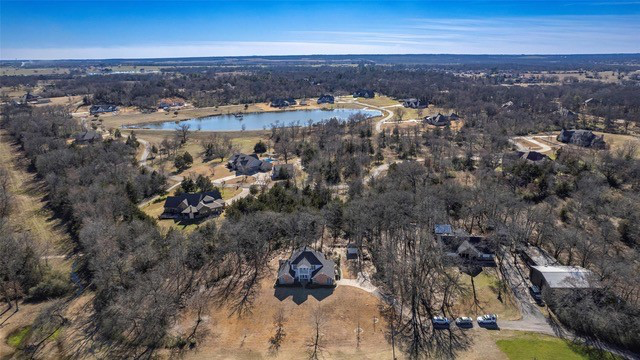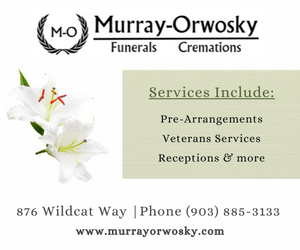New FEMA Policy Allows Houses of Worship to Apply for Disaster Relief Funds…What’s Next? by John Litzler

[adning id=”33097″]
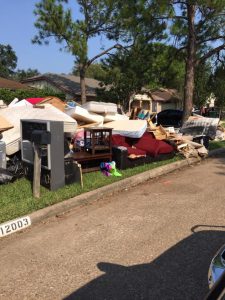
This week, the Federal Emergency Management Agency (FEMA) released its 2018 Public Assistance Program and Policy Guide. The FEMA Public Assistance (PA) program is a grant program that provides disaster relief funds to, private nonprofit organizations, among other groups.
Historically, FEMA has determined houses of worship to be ineligible private nonprofit organizations. After Hurricane Katrina hit Louisiana in 2005, FEMA, then under the direction of President George W. Bush, reimbursed churches for shelter, food, and supplies the churches provided to the general public. However, FEMA did not provide PA grants to rebuild a damaged facility if the facility was established or primarily used for a religious purpose. Since that time, “facilities established or primarily used for political, athletic, religious, recreational, vocational, or academic training, conferences, or similar activities” have not been eligible for the PA program.
The 2018 PA Program and Policy Guide removes the word “religious” from the list of ineligible nonprofits. Furthermore, even though the policy changed this week, the changes are effective for disasters declared on or after August 23, 2017. President Trump declared the Hurricane Harvey disaster on August 25th. After Hurricane Harvey, FEMA obligated PA grants in the amount of $504,353,860.08. Churches are now eligible to apply for those funds. (This amount is separate from the $1,511,204,391.21 approved under the individual and households program). Now, churches may apply for a portion of the over half billion dollars of Hurricane Harvey disaster relief grants.
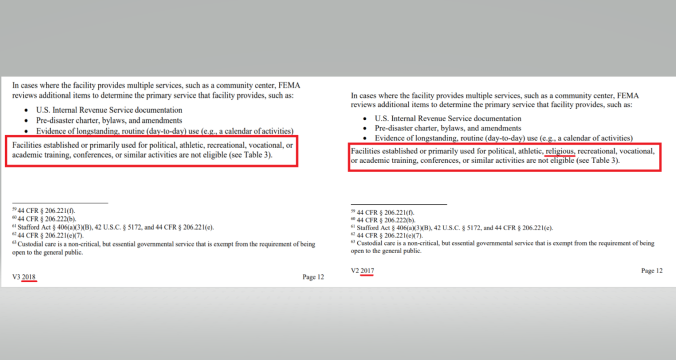
Why the change?
In September, three Texas churches filed a federal lawsuit in the Southern District of Texas alleging FEMA’s policy “categorically excludes houses of worship from equal access to disaster relief grants because of their religious status.” The three churches (Harvest Family Church in Cypress, TX, Hi-Way Tabernacle in Cleveland, TX, and Rockport Fist Assembly of God) all suffered damage from Hurricane Harvey in August. Two synagogues in Florida also filed a lawsuit against FEMA after suffering hurricane damage.
Additionally, the churches had the support of Texas Governor Greg Abbott and President Donald Trump. The President is responsible for declaring a state of emergency and administers funds following disasters. In September, President Trump tweeted: “Churches in Texas should be entitled to reimbursement from FEMA relief funds for helping victims of hurricane Harvey (just like others).”
How does a House of Worship apply for a grant under the PA program?
First, for a nonprofit organization to qualify for the PA program, it must have been granted tax-exempt status under Sections 501(c), (d), or (e) of the Internal Revenue Code of 1954. Because all churches and other houses of worship are automatically considered 501(c)(3) organizations under the Code, this requirement is easily met.
Second, for a church (or other house of worship) to qualify under the PA program, the President must make a major disaster declaration in the county where the church is located. On August 25, 2017, President Trump declared a major disaster in Texas in the wake of Hurricane Harvey. Counties where churches may qualify for the PA program include (but are not necessarily limited to) Aransas, Austin, Bastrop, Bee, Brazoria, Caldwell, Calhoun, Chambers, Colorado, DeWitt, Fayette, Fort Bend, Galveston, Goliad, Gonzales, Grimes, Hardin, Harris, Jackson, Jasper, Jefferson, Karnes, Kleberg, Lavaca, Lee, Liberty, Matagorda, Montgomery, Newton, Nueces, Orange, Polk, Refugio, Sabine, San Jacinto, San Patricio, Tyler, Victoria, Walker, Waller, and Wharton. Typically, a church will only have 30 days from the date of the disaster declaration to apply. Because of the FEMA policy change, however, churches may apply if their facilities suffered damage from an event declared a major disaster on or after August 23, 2017 (this covers Hurricane Harvey).
Third, the church must either:
(1) provide a critical service, or
(2) provide a non-critical but essential governmental service AND be open to the general public.
Critical services are defined as education, utility, emergency, and medical services. Most churches do not provide critical services, but a church that operates a private school, for example, may persuade FEMA that the education provided by the school means that the church provides a critical service. Non-critical but essential government services have historically been broadly defined by FEMA to include activities such as sewing and stamp/coin collecting. In the 2018 PA Program and Policy Guide, FEMA is clear that churches provide non-critical but essential government services. Eligible non-critical but essential governmental-type services include “activities of community centers or houses of worship open to the general public, without regard to their secular or religious nature.”
Finally, if the church does not provide a critical service (education, utility, emergency, or medical) it must apply for a loan from the Small Business Administration (SBA) before applying for a PA program grant. The PA program grant is limited to the amount that the SBA loan will not cover.
Any other important aspects of the PA program?
For each disaster, the President sets a cost share. The federal government’s share cannot be lower than 75%, which can leave up to 25% of the cost to the grantee under the PA program. The cost share for FEMA on Hurricane Harvey grants is 90%. PA program grants may be offset by other funds the grantee receives (e.g. a loan from the SBA or insurance proceeds).
FEMA will also only cover disaster relief expenses that it deems reasonable. Grantees will need to show that they have done their due diligence in securing estimates from multiple bidders and that the quotes they receive are reasonable considering several factors, including historical comparisons for similar goods/services in the grantee’s geographic location. FEMA can still review obligated funds to a grantee up to three years after the closeout of the grant.
Resources:
You can find the 2018 Public Assistance Program Policy Guide here.
Additional information is available on the FEMA website.
You can apply for FEMA assistance online here and for an SBA loan online here.
For more analysis on the church lawsuits and the current religious legal landscape, see our blog post from September.
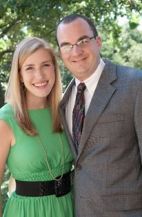
John Litzler directs the Church Law division of Christian Unity Ministries in San Antonio. He is a graduate of the University of Texas and Baylor Law school. He is a member of the SSHS class of 2004.
[adning id=”33207″]
[adning id=”33207″]
[adning id=”33207″]

